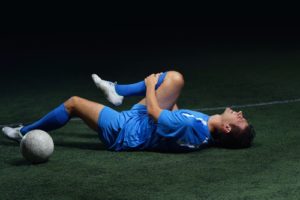“Coping with injuries is always difficult for athletes because all we want to do is, basically, to have our best performances unhindered.” – Ashton Eaton
 I think we all can agree that being hindered with an injury when you are an athlete is an emotional roller coaster. Everything in your mind, body and soul is screaming at you and telling you different things. The most important thing any athlete must remember is that diagnosing a sports injury is complicated. There are so many factors that go into finding the root of the injury. We believe that Neurokinetic Therapy can find the root of any injury. Below is an explanation as to how Neurokinetic therapy can help diagnose sports injuries.
I think we all can agree that being hindered with an injury when you are an athlete is an emotional roller coaster. Everything in your mind, body and soul is screaming at you and telling you different things. The most important thing any athlete must remember is that diagnosing a sports injury is complicated. There are so many factors that go into finding the root of the injury. We believe that Neurokinetic Therapy can find the root of any injury. Below is an explanation as to how Neurokinetic therapy can help diagnose sports injuries.
What is Neurokinetic Therapy?
Before we explain how Neurokinetic Therapy can help diagnose sports injuries, we want to define what Neurokinetic therapy is. David Weinstock, co-developed the Neurokinetic Therapy technique in the mid-1980s, and has used it to treat a variety of disorders. Neurokinetic Therapy is a sophisticated form of manual therapy that combines motor control theory and manual muscle testing. The science of motor control theory states that the motor control center in the cerebellum stores all the coordination patterns of the body. It is directed by the limbic system and the cerebral cortex to not only create movement patterns (such as when a baby learns to stand), but also to create substitute movement patterns when we are injured. Neurokinetic Therapy™ restores your body back to its proper easy and graceful movement and balance.
Neurokinetic Therapy™ and Sports
Many professional sports teams are using Neurokinetic Therapy™ to keep their athletes in top performance, prevent injuries, and heal injuries fast. Many baseball players turn to Neurokinetic Therapy™ when they sustain a rotator cuff injury. For some of these pitchers, this type of therapy is used before surgery. It can help heal their injury without the need for surgery. If surgery is in order, these players will use Neurokinetic Therapy™ during their rehabilitation process.
Athletes in all shapes, sizes and forms, are turning to Neurokinetic Therapy™. There is little doubt that Neurokinetic Therapy™ can increase an athlete’s performance, the risk of injury is lowered, and it will help in the recovery of an existing ailment. Neurokinetic Therapy™ can give you the edge that may significantly increase your speed, endurance, focus, strength, balance, coordination, and accuracy when you need them most.
Diagnosing sports injuries through Neurokinetic Therapy
Neurokinetic Therapy (NKT) consists of a series of specific muscle tests to determine muscle compensation patterns specific to everyone. Muscles that become painful are often tight from being overworked due to under-utilized muscles elsewhere. With the use of NKT Therapy, new motor programs are established with the use of soft tissue releases and corrective exercises to combat chronically tight muscles and lingering pain. Kinetic Therapy is an innovative approach to manually testing the muscles throughout the pain points and the linked areas of the body.
At Pain and Performance Solutions we will take you through a variety of muscle tests throughout the entire body with Neurokinetic Therapy. Light pressure is applied to the body, so we can evaluate the strength or weakness of each muscle. Revealing an inhibited muscle throughout the entire kinetic chain, will help to reveal the source of injury and the compensation mechanism responsible for pain. Our patients can expect to receive specific home exercises, so your body can reprogram faulty movement patterns following a Neurokinetic Therapy session.
Moving forward with Neurokinetic Therapy
The ability to diagnose an injury and treat it properly so an athlete can return to optimal strength isn’t an easy task. We all know athletes are chomping at the bit to get back as quickly as possible. But patience is the key. However, we believe using Neurokinetic therapy to diagnose sports injuries will help you get back to ultimate performance quicker and without set back. Understanding the way your body moves through pain and how it’s been compensating for that improper function is key to your recovery. Pain and Performance Solutions believes in NKT and would love to give set up a consultation with you, so we can learn more about your sports injury and we can explain how Neurokinetic therapy can help diagnose sports injuries in more detail.
 Frequently Asked Questions
Frequently Asked Questions
1. What is Neurokinetic Therapy (NKT)?
Neurokinetic Therapy (NKT) is a specialized form of manual therapy developed by David Weinstock in the mid-1980s. It combines motor control theory with manual muscle testing to assess and correct dysfunctional movement patterns. The therapy targets compensatory muscle patterns that develop after an injury, aiming to restore normal movement and alleviate pain.
2. How does Neurokinetic Therapy help diagnose sports injuries?
NKT helps diagnose sports injuries by using specific muscle tests to identify dysfunctional compensation patterns in the body. When an injury occurs, some muscles become overworked to compensate for weaker or inhibited ones. Through NKT, therapists can determine which muscles are overworking and which are underperforming, allowing them to pinpoint the root cause of the injury.
3. Why do athletes use Neurokinetic Therapy?
Athletes use NKT to enhance their performance, prevent injuries, and speed up recovery. The therapy helps identify and correct dysfunctional movement patterns, improving balance, strength, coordination, and accuracy. For many athletes, NKT is used as a preventative measure or as part of rehabilitation to avoid surgery or to recover more quickly after surgery.
4. What sports injuries can be treated with Neurokinetic Therapy?
Neurokinetic Therapy can treat a wide range of sports injuries, such as rotator cuff injuries, lower back pain, and tight muscles resulting from overcompensation. Whether it’s to prevent injuries or to aid recovery, NKT is used by athletes across various sports including baseball, where pitchers often use it to recover from shoulder issues.
5. How does Neurokinetic Therapy improve athletic performance?
NKT improves athletic performance by correcting dysfunctional movement patterns, allowing athletes to move more efficiently and without pain. This can lead to improved strength, endurance, balance, speed, and accuracy. By identifying and resolving compensatory muscle patterns, athletes can achieve optimal performance without the risk of injury or strain.
6. What should I expect during a Neurokinetic Therapy session?
During an NKT session, a therapist will perform specific muscle tests to evaluate the strength and weakness of various muscles. Light pressure is applied to different areas of the body, and you’ll be asked to resist this pressure to assess muscle performance. Based on these tests, the therapist can identify inhibited muscles and develop a personalized exercise plan to correct the compensation patterns.
7. Can Neurokinetic Therapy help prevent surgery for sports injuries?
Yes, in many cases, athletes use NKT to avoid surgery by addressing the root cause of the injury early. By correcting dysfunctional movement patterns and relieving pain, NKT can help prevent the need for surgical intervention. Even if surgery is unavoidable, NKT is often used in the rehabilitation process to speed up recovery.
8. How does Neurokinetic Therapy reprogram faulty movement patterns?
NKT reprograms faulty movement patterns by using a combination of soft tissue releases and corrective exercises. This process retrains the motor control center in the cerebellum, which stores coordination patterns, helping to eliminate compensation patterns caused by injury and restore proper movement.
9. What types of exercises are recommended after a Neurokinetic Therapy session?
After a Neurokinetic Therapy session, patients are often given specific exercises designed to reprogram the body’s movement patterns. These exercises help strengthen inhibited muscles and reinforce the correct movement patterns, ensuring that the dysfunctional compensation patterns do not return.
10. How quickly can I return to sports after Neurokinetic Therapy?
The recovery time varies depending on the severity of the injury and the individual’s response to the therapy. While athletes are often eager to return to their sport, patience is key. NKT aims to restore optimal performance as quickly as possible, but it’s important to allow the body time to fully recover and to prevent setbacks.

